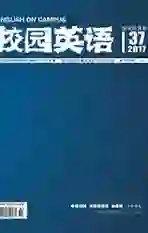English and Chinese Translation
2017-12-21YeSiqi
Ye+Siqi
【Abstract】This thesis compares lexical distribution between English language and Chinese language and raises three aims including free translation, semantic translation and translation containing semantic principal and context. Thus, the authentic degree of lexical translation depends on the context.
【Key words】lexis; linguistic context; situational context; cultural context; translation
1. Introduction
Translating English into Chinese and vice versa, translators are confront with unavoidable bottleneck problem..
2. Analysis
I would like to illustrate an example. “汨羅江附近的老百姓听到屈原自杀的消息,都纷纷赶来,划着渔船,拿着竹竿,四处打捞屈原的遗体,结果什么也没有打捞到。”Observing this sentence carefully and analyzing a series of verbs, we need to concentrate on the Chinese phrase “打捞”and we should translate the sentence as:On hearing the news of his suicide, people who lived nearby came hurriedly in boats and attempted to retrieve his body with long bamboo poles but, to their distress, without arrival. In this way, the translation of sentence will be more naturally and logically.
2.1 Lexical conversion
The previous example illustrates lexical conversion. Nouns and verbs account for a large proportion of vocabularies among all kinds of languages. From the two previous aspects, we find that Chinese language shows obvious dynamic nature. English language shows static feature.
Translating process contains necessary lexical conversion. When translating English into Chinese, translator should convert nouns, prepositional phrases of English, etc. into relevant verbs or verb-phrases of Chinese. I will illustrate an example. “He was a clever man;a pleasant companion;a careless student;with a great propensity for running into debt, and a partiality for the tavern.” Analyzing this sentence, wed better convert nouns into verbs then translate it as “他人很聪明,容易相处,但学习粗心大意,老是借债,嗜好喝酒。”
2.2 Translation context
What is translation context?What is the relationship between lexis and context?Professor Zhuanglin Hu (1994) made a classification for lexis and context. First, Linguistic context. A word may contain several meanings. Furthermore, a word or phrase in different sentences may include more than two interpretations. Take “credit” for instance:(1) No credit is given at our shop. 本店概不赊账。(2) The bank refused further credits to the company. 银行拒绝再次贷款给这家公司。Second, Situational context. What is semantic translation?J. A. Fishman(1965) described it as considering time and place. Here is a title, “The Tourism of Tibet:Reveal the Mysterious Veil” . Observing the title “The Tourism of Tibet:Reveal the Mysterious Veil”, we find the key word is “veil” which contains several relevant Chinese meanings, such as “遮蔽物”, “托词”, “面罩”, etc. It is lack of accuracy to use these words as a part of title. So translator must think about situational context of text. From the perspective of text, it is better to translate “The Tourism of Tibet:Reveal the Mysterious Veil” as “西藏旅游:揭去神秘的面纱” . Third, Cultural context. It involves social, cultural, economic, religious, political elements, etc. Take a short Chinese text as example:中国的春节在农历一月一日,是新一年的开始。在除夕之夜,多数农村家庭仍保持着一些传统习俗,如在两扇门上都贴上门神和春联。他们把“福”字倒贴在墙上和家具的门上,意思是“福到了”。It introduces Chinese traditional Spring Festival. Translator should know cultural background of Spring Festival, such as door gods, couplets, etc. and clear their implications. Chinese traditional culture shows that the aim of pasting paintings of door gods on the two doors is to protect people from invasion of evils. Painting couplets is to use characters which symbolizes simple and subtle patterns to express best wishes for future life, which is the unique literary culture of China. The Spring Festival is coming when people paste the Chinese character “福” upside down on walls and doors of the furniture. It is a homophonic feature that the upside character implies happiness has come. Hence, when translating cultural elements of vocabularies, translator must understand relevant cultural background adequately. So, we can translate it as:According to the Chinese lunar calendar, the Spring Festival falls on the first day of the first month. On the New Years eve, most of the families in the countryside still keep the customs of pasting paintings of door gods on the two doors and couplets on two side of the doors. They put the Chinese character meaning “happiness” upside down and paste it on walls and doors of the furniture to mean “happiness has come.”
3. Conclusion
Translation includes three contexts, linguistic context, situational context and cultural context. When translating text, translators need to consider vocabulary and context together.
References:
[1]Peter Newmark.A Textbook of Translation[M].Shanghai: Shanghai Foreign Language Education Press,2001.
作者简介:叶思琪(1993.9-),女,重庆师范大学外国语学院在读硕士,研究方向:英语语言文学。
